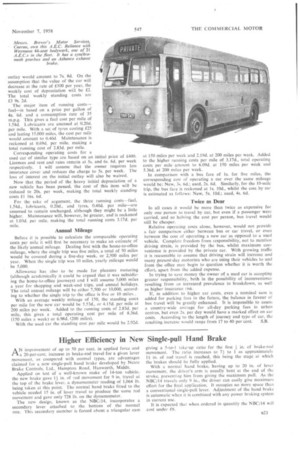Higher Efficiency in New Single-pull Hand Brake
Page 97

If you've noticed an error in this article please click here to report it so we can fix it.
AN improvement of up to 50 per cent, in applied force and a 20-per-cent. increase in brake-rod travel for a given lever movement, as compared with normal types, are advantages claimed for a new single-pull hand brake developed by Neate Brake Controls, Ltd., Hampton Road, Hanworth, Middx. Applied on test of a well-known make of I4-ton vehicle, the new brake gave 1 I in. of rod movement for 9 in. travel at the top of the brake lever, a dynamometer reading of 1,064 lb. being taken at this point. The normal hand brake fitted to the vehicle needed 15 in. of lever travel to produce the same rod movement and gave only 728 lb. on the dynamometer. The new design, known as the NBC/14, incorporates a secondary lever attached to the bottom of the normal one. This secondary member is forced about a triangular earn giving a 5-to-1 take-up ratio for the first .1 in. of brake-rod movement. The ratio increases to 7-1 to 1 as approximately 11 in. of rod travel is reached, this being the stage at which the brakes should be fully applied. With a normal hand brake, having up to 20 in. of lever movement, the driver's arm is usually bent at the end of the stroke, preventing him from giving the maximum pull. As the NBC/14 travels only 9 in., the driver can easily give maximum effort for the final application. It occupies no more space than a conventional single-pull lever. Adjustment of the hand brake is automatic when it is combined with any power braking system in current use. It is expected that when ordered in quantity the NBC/14 will cost under £8.












































































































































